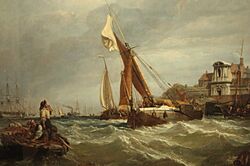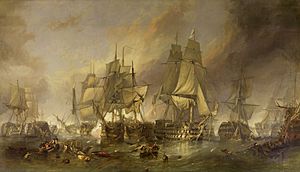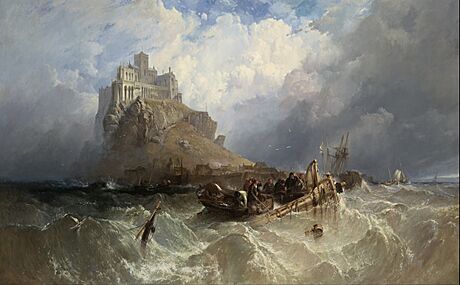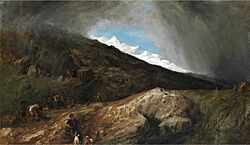Clarkson Frederick Stanfield facts for kids
Quick facts for kids
Clarkson Frederick Stanfield
RA RBA
|
|
|---|---|

Portrait of Clarkson Stanfield by John Simpson circa 1829
|
|
| Born | 3 December 1793 Sunderland, England
|
| Died | 18 May 1867 (aged 73) London, England
|
| Resting place | Kensal Green Catholic Cemetery |
| Nationality | British |
| Spouse(s) | (1) Mary Hutchinson; (2) Rebecca Adcock |
| Military career | |
| Allegiance | |
| Service/ |
|
| Years of service | 1808–14 |
| Unit | HMS Namur |
Clarkson Frederick Stanfield (3 December 1793 – 18 May 1867) was a famous English painter. He was best known for his large and exciting paintings of the sea and landscapes. He was the father of painter George Clarkson Stanfield and composer Francis Stanfield.
Contents
Becoming a Painter: Early Life
Clarkson Stanfield was born in Sunderland. His father, James Field Stanfield, was a writer and actor who used to be a sailor. His mother, Mary Hoad, was also an artist and actress. Clarkson likely got his artistic talent from his mother. She was a skilled artist but sadly passed away in 1801.
He was named after Thomas Clarkson, who worked to end the slave trade. His father knew Thomas Clarkson well.
In 1806, Clarkson briefly worked for a coach decorator. But he left and became a sailor on a coal ship. In 1808, he was forced to join the Royal Navy. He served on the ship HMS Namur. He left the Navy in 1814 due to health reasons. In 1815, he sailed to China on the ship Warley. He came back with many sketches from his travels.
Painting for the Stage: Scenery and Spectacles
An accident meant Stanfield could no longer be an active sailor. But his time at sea helped him become a very good artist. In 1816, he started working as a decorator and scene-painter at the Royalty Theatre in London. He also worked at the Coburg Theatre with David Roberts.
By 1823, he became the main scene-painter at the Theatre Royal, Drury Lane. He quickly became famous for creating huge, amazing scenery and moving dioramas. He made these for the theatre until 1834.
Stanfield stopped painting scenery after 1834. But he still helped his friends, like William Charles Macready and Charles Dickens, with their plays.
Giant Moving Paintings: Dioramas and Panoramas
Stanfield worked with David Roberts on big diorama and panorama projects. These were huge paintings that unrolled like giant scrolls. They had sound and lighting effects, like an early form of cinema! Stanfield and Roberts made eight of these shows. Two famous ones were about naval battles: the Bombardment of Algiers and The Battle of Navarino.
In 1830, Stanfield traveled through Germany and Italy. This trip gave him ideas for two more moving panoramas. These were The Military Pass of the Simplon (1830) and Venice and Its Adjacent Islands (1831). He painted the first one in just eleven days and earned £300! The Venice panorama was 300 feet long and 20 feet high. It was lit by gas and took 15 to 20 minutes to unroll. The show even had stage props and singing gondoliers.
These moving panoramas became popular parts of traditional Christmas pantomime shows.
Becoming a Famous Artist: Mature Career
While doing stage work, Stanfield also became a skilled easel painter, especially of sea scenes. He first showed his art at the Royal Academy in 1820. He was also a founder of the Society of British Artists in 1824 and its president in 1829.
He became an Associate Member of the Royal Academy in 1832. Then, in 1835, he became a full Academician. King William IV admired his painting St. Michael's Mount (1831). The King then asked him to paint two works: Opening of New London Bridge (1832) and The Entrance to Portsmouth Harbour. These paintings are still in the Royal Collection today.
Until he died, Stanfield created many popular paintings for the Academy. These included sea scenes and landscapes from his travels in Europe and Ireland. Some of his well-known works include:
- The Battle of Trafalgar (1836)
- Castle of Ischia (1841)
- HMS The Victory Bearing the Body of Nelson Towed into Gibraltar after the Battle of Trafalgar (1853)
He also created two series of paintings about Venice for important homes. He illustrated books like Captain Marryat's The Pirate and the Three Cutters (1836). He also published collections of his own drawings, like Stanfield's Coast Scenery (1836).
How People Saw His Art

Stanfield's early work as a scene-painter greatly influenced his art. His paintings often had a grand, dramatic feel. They were known for their strong atmospheric effects and good composition. He showed a deep understanding of the art materials he used.
The art critic John Ruskin thought Stanfield's paintings of the sea and clouds were excellent. He called him the "leader of our English Realists." Ruskin also noted that Stanfield's sketches, especially in watercolor, were often better than some of his finished oil paintings.
Later Life and Legacy
In his last ten years, Stanfield's health got worse. He passed away in Hampstead, London, on May 18, 1867. He was buried in Kensal Green Catholic Cemetery.
His lifelong friend, the writer Charles Dickens, visited him on the day he died. After Stanfield's death, Dickens wrote about him. He said Stanfield was "the soul of frankness, generosity and simplicity." He called him "the most lovable of men" and said success never changed him.
In 1870, three years after he died, a big exhibition of Stanfield's work was held. The Times newspaper wrote that his paintings were very popular. They praised his skill in composition, his pleasant colors, and his love for the sea and ships. They said he was "one of the most popular, if not the most popular, of landscape painters."
Family Life
People admired Stanfield not only for his art but also for his simple and humble personality. He was born Catholic and became more religious later in life. This happened after some sad losses in his family, including the death of his eldest son in 1838.
His oldest son who survived, George Clarkson Stanfield (1828–78), also became a painter. His father taught him a lot. Another son, Francis Stanfield (1835–1914), became a Catholic priest and wrote several well-known hymns.
Images for kids











